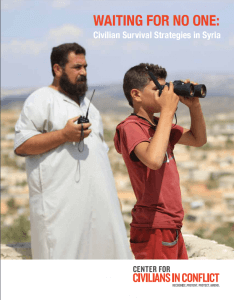In times of intense conflict and pervasive violence, how do civilians cope? The most recent report from the Center for Civilians in Conflict (CIVIC), “Waiting for No One: Civilian Survival Strategies in Syria,” details coping strategies used by Syrian civilians during the brutal civil war to ensure their own safety and assist others. Based on research and interviews with Syrians in Turkey, Lebanon, and Syria, as well as NGOs, UN agencies, and members of Syrian civil society, the report reveals a system of local approaches to self-protection used by civilians across the country. CIVIC recommends that the international response to the Syrian civil war support and expand the coping mechanisms employed by Syrian civilians, especially in the creation of a secure platform for Syrians to share protection strategies with others around the country. Underscoring the key elements of results-based protection, the report focuses on building upon the coping mechanisms and protection strategies of communities themselves, which offered participants in the webinar a chance to discuss opportunities to promote this practice across contexts.
While the CIVIC report is focused on the Syrian context, its findings are relevant to contexts characterized by a high tempo of hostilities and the use of explosive weapons in urban areas, such as Gaza, Iraq, or Yemen.
In order to provide a contextual overview of the state of explosive violence around the world, Iain Overton, Director of Policy and Investigations at Action on Armed Violence (AOAV), introduced the conversation with findings from AOAV’s most recent explosive violence report, “Unacceptable Harm: Monitoring explosive violence in 2015.”
Following this introduction, the discussion focused on the survival strategies of civilians in conflict, based on the findings of the CIVIC report. Natasha Hall, Program Officer with CIVIC and author of the report, presented the main findings and recommendations, which include the need for early warning systems, protection of medical infrastructure and educational facilities, support for local rescue and aid teams, protection from unexploded ordnance, and the development of a platform for self-protection strategies.
Following the presentations, participants discussed ways to promote civilians’ self-protection efforts, the long term harm created by the use of explosive weapons, and the practicality of supporting a platform of self-protection strategies on a broad scale.
